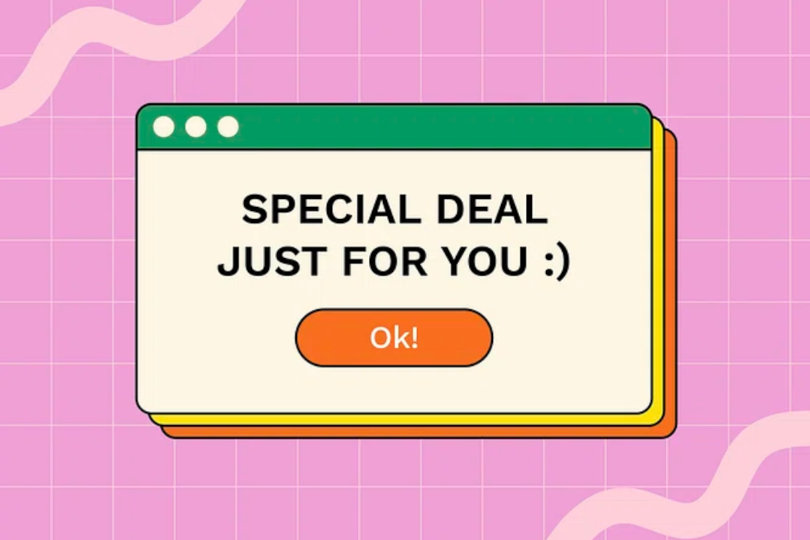The subject of implementing pop-up messages on the website is debatable among marketers. The statistics from HubSpot show that 64% of customers find pop-up notifications annoying and intrusive. However, global brands such as Lego, Airbnb, Adidas, Ikea and others still use pop up message(s).
So what is the secret of these page elements appearing while users browse the site? Their success depends on many factors. In this article, we will look at the tactics that can help craft user-oriented pop-ups to increase conversion and user engagement.
![]()
What Are Pop-Ups?
As the name implies, a pop-up is a website element that appears with a certain message. The functionality of such notifications lies in the fact that they can serve many purposes. Marketers use them to announce an offer, gather feedback, invite people to subscribe to newsletters or display any other kind of information.
If not created properly, users might be annoyed by pop-up messages due to the following:
- They appear very often. When visitors just landed on the website and didn’t figure out what it is, and you over-burden them with new information, it will not play in your favor. The same applies when you implement pop-up elements very often.
- Prevent viewing the main content. The pop-up element is not created correctly if it covers the whole page and nothing can be seen through it.
- Cannot be closed. If the message is difficult to close, it will cause a lot of user dissatisfaction. They can even close the page without waiting until the closing button works.
What Are the Best Tactics to Create a Powerful Pop-Up?
This small message may seem very easy to craft. However, its creation requires thorough analysis of many aspects. Here are some rules that will help you create effective and not intrusive pop-ups.
Define the Pop-Up Goal
In this message every little detail matters. Think about what you would like to achieve with a pop-up notification. It should be a concise message that will not take more than several seconds to comprehend. Include interactive widgets in your message such as buttons, timers, progress bars, forms or any others that require a user’s action.
Create Personalized Content
The best way to catch a visitors’ attention is to tailor the pop-up message to their needs and interests. Depending on an individual, a notification should show the relevant information or even not show up at all. For example, based on what a user was searching for, you can offer a blog post to learn more about that. Or show what products they were viewing. Offer alternative options if these products are not currently available.
For that matter, you can set rules, and the message will show up when the products are out of stock or a visitor has finished scrolling the page. For example, if you want to run a pop-up that encourages customers to subscribe to newsletters, it should be displayed for those not subscribed yet.
Show It at an Appropriate Time and in Moderation
No matter how exclusive your offer is, if it is shown from the first seconds visitors enter the website, it won’t have any value. Customers don’t know your brand yet; they are just exploring your website and won’t know how to apply what you offer. By analyzing a user journey, you can see when it is the most appropriate time to catch the visitors’ attention.
Another rule for an effective pop-up message is to show it in moderation. These notifications really work, and they can bring positive results, but if shown on every corner and every five seconds, viewers will simply leave your platform. If a user dismissed the message for the first time, don’t show it again.
Create Different Formats
The success of any pop-up message also depends on its format. There are different formats for desktops and mobile devices. Thus, you have to build different pop-ups for different platforms.
The size of the message also matters. It is ineffective if notifications cover the whole screen and a user can see nothing but the offer you promote. Don’t use overlays if you choose to display it at the center of the screen.

What Pop-Ups Do Users Like?
Customers love pop-ups if they provide value for them. Use these ideas to satisfy your clients:
- Offer discounts. Most visitors come to your website just to look at it. Not everyone is eager to buy from you from the very start. However, you can increase their desire to shop by offering an appealing discount. A great example of an offer is a spin-to-win pop-up message. The idea that you can get something for free or with a discount is more than attractive.
- Provide social proof. User reviews are what customers are looking for when considering a purchase. They want to see that the product is of high quality and that people who bought it are satisfied. So, provide this social proof in your pop-up message. Use written user reviews or videos to show what your clients think about your brand.
- Personalized recommendations. A few customers come to the website with a clear vision of what they want. But you can create personalized pop-up messages about what they would like based on their web search history.
- Limited time offers. Who wouldn’t like to buy a product at 50% off? And if such an offer is limited in time, it looks even more appealing. The timeframe influences the process of decision making and most customers will consider the offer now.
Conclusion
Pop-up messages might be annoying, but they might be engaging if designed correctly. The best tactics to follow are to set a clear goal for the pop-up, make it user-centric, show it at an appropriate time, and display it in the right format.
The idea of a good pop-up message lies in the value it provides for a customer. Thus, think of a user first and then create a pop-up.
Quelle: Source link www.noobpreneur.com

